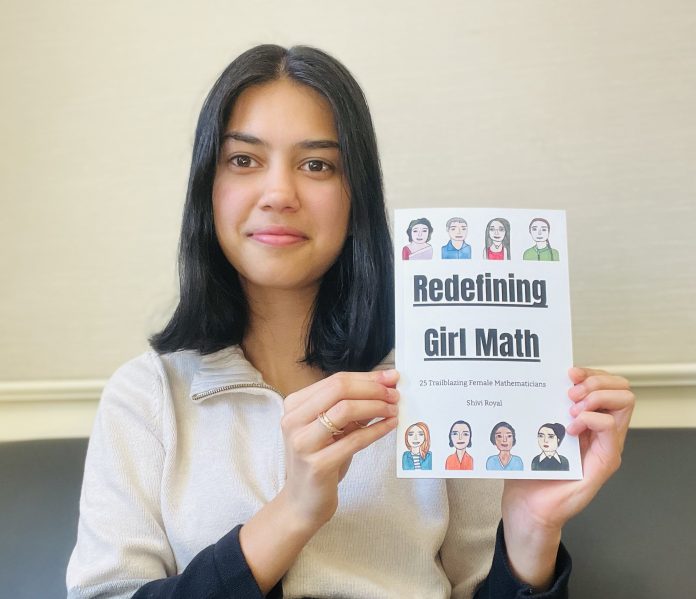For months, the idea of “girl math” has dominated pop culture. From TikTok influencers’ shopping hauls to casual conversations amongst friends, the term has widely become associated with women’s consumerism and spending habits. However, Computational and Applied Mathematics major Shivi Royal ‘27 is working to reshape the term in favor of female mathematicians by compiling their inspirational stories in her book, “Redefining Girl Math: 25 Trailblazing Female Mathematicians.”
“Girl math” is often used to describe women’s potentially-illogical financial calculations: for instance, according to girl math, anything bought with cash is free. Royal said that as she began to learn the meaning of “girl math,” she was determined to redefine the term for younger girls who were only becoming familiar with the pop culture definition.
“I don’t know why people were promoting that type of thinking, and then especially tagging ‘girl math’ at the end of that,” Royal said. “I know there’s many girls like me who are studying so hard in our math classes, and then there’s these jokes.”
Royal nodded to the use of the slogan by famous influencers and in social media content sponsored by companies, which she said has made her especially disappointed.
“What really drove me over the edge was seeing female YouTubers who would, if they got sponsored with certain deals like Pizza Hut or something, use that in their advertisement,” Royal said. “Like, ‘Oh, we gotta get on the shopping spree, girl math.’ It was very frustrating for me.”
Beginning in the summer of 2023, Royal, who enjoys watercolors, started painting portraits of female mathematicians. Royal said that as she did more portraits, she was inspired to look into the lives and scientific careers of the women she was painting, leading her to write a collection of biographies about female mathematicians.
Royal began the writing process by narrowing down to 25 female mathematicians to focus on and research. Royal used the University of St. Andrews archive database for much of her research and she said she worked to look into mathematicians from varying time periods and from all over the world.
“The female mathematicians that I wrote about, they impacted the people that inspired others to learn math,” Royal said. “They also brought social change to their society.”
After she finished the original manuscript, Royal said she began reaching out to those around her to help her with the editing and revision process. She said her AP English Language teacher, her parents and her aunt — who is a middle school math teacher — all played a pivotal role in the editing process.
Royal did most of the editing on her manuscript within her first few months of her first fall semester at the College of William and Mary, and she said she would always find time to work on her passion project. Once she finished the revision process, she made the layout for the book, which included the watercolor portraits she had made of the women. The book was published online through Amazon and Barnes and Noble in December 2023.
Royal said that by publishing the book, she hopes to bring about a new meaning of girl math for young women. She said many girls have low confidence when it comes to mathematical skills, and she has observed that the men in her math classes tend to be more outspoken about their incorrect answers and are willing to confront the professor when they think that they are in the right. She hopes the books can act as encouragement for young girls to become more confident mathematicians.
“I was looking into a lot of research about lack of self esteem and what was very shocking to me was that if there was a boy and a girl who performed equally, or if the girl performed higher on her math exam, she had very less confidence in her computational abilities than her male counterpart, which baffled me. It all comes down to self confidence,” Royal said. “The first thing I hear so many girls say is, ‘I just can’t do that. I’m not good at it. I’m not good at numbers.’”
Royal said she is also working to change the stereotypical idea of a mathematician for future generations. She said many young girls don’t see themselves as mathematicians because of norms reinforced throughout society.
“It’s that stigma that the first person you would think of who’s a scientist, or if you imagine a mathematician in your head, it would most likely be a male,” Royal said. “There’s that stigma and that lack of representation, yes, but hopefully we can change that for the future.”
Royal said she has seen an increase in women in her math classes, which is something she attributes to the increased support for the Women in STEM movement. Throughout Royal’s AP math classes in high school and her upper-level math courses at the College, she has noticed the number of women rise.
Additionally, Royal said representation of women in STEM fields making its way into the media has helped to raise awareness for women in STEM who have often been forgotten by history.
“Once they come into pop culture, they become very well renowned, like in ‘Hidden Figures,’” Royal said. “Nobody knew about those mathematicians and engineers until there was a movie made for them. It’s just a choice of which story gets their shot into the media.”
Royal said that by contributing to raising the awareness of female mathematicians through publishing her book, she hopes to permanently alter how young women view their ability to interact with math. She said she wants girls to see that there is more to it than just “girl math.”
“I want to show them that women have gone through many hurdles to be able to study mathematics, and also for any other girls out there who want to study mathematics, it’s an option that’s open to them,” Royal said.

